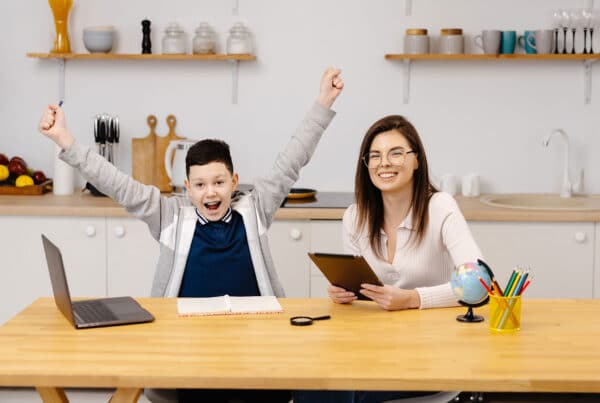Last Updated On: July 1st, 2024
Take Notice…
The first step is noticing.
Is my child reacting to this moment in a dramatic way?
Does it feel abnormal?
Are there signs that the stress is becoming overwhelming?
The CDC does a great job of breaking down some of the common ways to identify an anxiety disorder in your child:
“When a child does not outgrow the fears and worries that are typical in young children, or when there are so many fears and worries that they interfere with school, home, or play activities, the child may be diagnosed with an anxiety disorder.” To read more about how to identify anxiety or depression in your child, check out the full article at: Anxiety and Depression in Children.
How I can tell…
I can always tell when a child is experiencing anxiety if we make a game plan for their homework or projects and it leads to them spiraling about the future and how to get their enormous workload accomplished. Usually game plans help us manage anxiety and see the tasks at a wider glance, broken into small easy chunks. Typically that’s a stress reducer, but occasionally when worry is uncontrollable, game plans can become a trigger.
There are various types of anxiety. Sometimes a child’s stress results in panic attacks, sometimes it manifests in other forms of depression and hopelessness. I’ve even seen severe cases where the nervous energy and fear disables a student’s ability to start the task at hand.
If you’re seeing anything unusual, even if it feels like an overreaction to your child’s behavior, make sure to seek a trained counselor or therapist for their opinion. It’s best to let the mental health professionals handle any diagnosis so you can just be the parent and not the doctor as well. Especially if you’re a parent who works in mental health it’s important to know you must step back and allow your child the opportunity to see someone less involved in their daily life.
What now?…
If you can firmly say your child is diagnosed as anxious and suffering from an anxiety disorder, you must take action. Whether you believe in medication as treatment, talk therapy, or other more holistic therapies, you must encourage your kid to find a way to cope in their world. When anxiety is targeted around something so rooted in the adolescent culture, like school, it’s important to find strategies that focus on all types of anxiety.
Perhaps it’s social anxiety…
One way to help kids with these struggles is to remind them how important it is to think freely and abandon the idea of being exactly like everyone else. Social anxiety naturally comes from a place of wanting to be liked or wanting approval from those with authority and popularity.
→ Talk through their anxieties and fears. What will happen if the popular girl doesn’t like them? What happened to you when you were in school? What’s the worst case scenario? What’s the best case scenario? Of course they may take this with a grain of salt, but it’s important to show them that their problems, however small and petty they may seem, are important to you too.
→ Have them journal regularly. Tell them to jot down everything and read the entry prior. This will allow them to see progress they’ve made and obstacles they may have thought were catastrophes being resolved naturally. Being able to reflect and look back on their stresses with a clear mind will help them resolve the current fears that are rising to the surface.
Perhaps it’s more generalized anxiety…
This is also a very common form of anxiety I see more frequently in teens of this generation. Our world is so up in the air and uncontrolled. It’s terrifying for kids. They truly don’t have the grounding they once did, especially with a pandemic uprooting their whole lives. They fear for their future, their grades, their college experience, and utter chaos ensuing. No wonder AAP claims, “Anxiety disorders are the most common type of mental health disorder in childhood, affecting approximately 8% of all children and adolescents.” The Resilience Project > Anxiety Fact Sheet
→ Support emotional check ins. Have your child write down on a scale of 1 to 10 how anxious they feel at the start of the day. How about in the middle of the day when they finish school? How do they feel before bed? Is there a particular point in every day where their calm and confident demeanor takes a turn? Maybe it’s a particular class or teacher or assignment that revs up their adrenaline. Try seeing if you can help your child identify these moments so you can implement coping strategies at these exact points and avoid a panic attack.
→ At some point during the day have your child pinpoint any anxieties they have in their mind. Next, have them label the anxiety. What’s the fear? Is it something they need to fear at this exact moment or can it be tabled for another day? Is it a rational fear? You can definitely help at this point. And be honest, maybe it is a real fear. Go over the outcomes, help your child process the reality of the fear.
Once we have identified the fears…
Now that your child is getting better at identifying their anxiety it’s important to support them with coping. Make sure to have a cozy spot in your house where your child can go (preferably a more private setting) when they are having anxiety. Most adolescents don’t want physical touch when this is occurring and it’s important to honor their needs, but also have the tools ready when they need.
Depending on your child’s maturity they may also gain comfort from having an object that soothes them. If they’re in a school setting I recommend those squishy toys most kids simultaneously use as a concentration tool. Other simple objects like mechanical pencils and highlighters can have a similar effect when pushed into the paper or touched. Incorporating physical touch helps kids get out of their head and into the present moment. Read more about how to use this strategy, especially while testing, on our latest blog: Test Anxiety: Dealing With Stress During Your Test.
Never forget the power of deep breathing. While I have some students that resist this, it’s tried and true. When the anxiety comes on, take a break, walk away from the work. Sit down with feet grounded on the floor and take at least 20 deep breaths. Try to make the exhale longer than the inhale. If your child is slightly older, they may even want an app with a guided meditation for anxiety (Calm and Insight Timer are two popular apps).
Most importantly, use your words. They have so much power coming from a parent. Coping Skills for Kids has a great list of encouraging language to try when your kid hits an anxiety bout:
“I’m here for you”
“Talk to me and tell me what’s going on”
“How can I help?”
“Together, we can work on this. We’re a great team”
“I love you”
“Do you want a hug?”
And if all else fails, try finding a tutor for your student that brings a light hearted, easy-going attitude to your student’s school work. When kids have fun and look forward to their schoolwork and tutoring, they can truly find a light at the end of the stress tunnel. Check out a few of our tutors’ comments on students with anxiety and the best teaching styles for them: Hear From Our Tutors! What Tutoring Style is Most Effective?




















